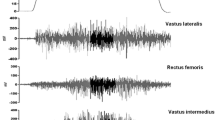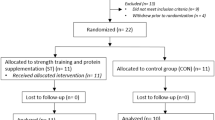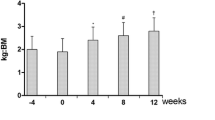Abstract
To assess effects of a short-term strength training (ST) program on muscle quality (MQ) and functional capacity, 36 sedentary elderly women (age = 66.0 ± 8 year, height = 159.1 ± 9.2 cm, body mass = 68.3 ± 12.1 kg, body fat = 37.0 ± 4.2 %) were randomly divided into an experimental group (EG; n = 19) or a control group (CG; n = 17). The EG performed two to three sets of 12–15 repeats of leg press, knee extension, and knee flexion exercises, 2 days/week for 6 weeks. Before and after training, lower body one repetition maximum (1RM), functional performance tests, quadriceps femoris muscle thickness (MT), and muscle quality (MQ) (1RM and quadriceps MT quotient) were assessed. After training, only the EG showed significant improvements in 1RM (p < 0.05), 30-s sit-to-stand (p < 0.001), and 8 foot up-and-go (p < 0.001). In addition, only in the EG, significant increases in all quadriceps femoris MT measurements (vastus lateralis, vastus medialis, vastus intermedius, and rectus femoris) (p ≤ 0.05), and MQ (p < 0.001) were demonstrated. No changes were observed in the CG. Furthermore, there were significant associations between individual changes in MQ and corresponding changes in 30-s sit-to-stand (r = 0.62, p < 0.001), and 8 foot up-and-go (r = −0.71, p < 0.001). In conclusion, a ST program of only 6 weeks was sufficient to enhance MQ of the knee extensors in elderly women, which resulted in beneficial changes in functional capacity.


Similar content being viewed by others
References
Aagaard P, Suetta C, Caserotti P, Magnusson SP, Kjaer M (2010) Role of the nervous system in sarcopenia and muscle atrophy with aging: strength training as a countermeasure. Scand J Med Sci Sports 20:49–64
Abe T, DeHoyos DV, Pollock ML, Garzarella L (2000) Time course for strength and muscle thickness changes following upper and lower body resistance training in men and women. Eur J Appl Physiol 81:174–180
Ahtiainen JP, Hoffren M, Hulmi JJ, Pietikäinen M, Mero AA, Avela J, Häkkinen K (2010) Panoramic ultrasonography is a valid method to measure changes in skeletal muscle cross-sectional area. Eur J Appl Physiol 108:273–279
Bottaro M, Machado SN, Nogueira W, Scales R, Veloso J (2007) Effect of high versus low-velocity resistance training on muscular fitness and functional performance in older men. Eur J Appl Physiol 99:257–264
Cadore EL, Izquierdo M, Alberton CL, Pinto RS, Conceição M, Cunha G, Radaelli R, Bottaro M, Trindade GT, Kruel LF (2012) Strength prior to endurance intra-session exercise sequence optimizes neuromuscular and cardiovascular gains in elderly men. Exp Gerontol 47:164–169
Cadore EL, Izquierdo M, Pinto SS, Alberton CL, Pinto RS, Baroni BM, Vaz MA, Lanferdini FJ, Radaelli R, González-Izal M, Bottaro M, Kruel LF (2013) Neuromuscular adaptations to concurrent training in the elderly: effects of intrasession exercise sequence. Age (Dordr) 35:891–903
Carmeli E, Reznick AZ, Coleman R, Carmeli V (2000) Muscle strength and mass of lower extremities in relation to functional abilities in elderly adults. Gerontology 46:249–257
Caserotti P, Aagaard P, Simonsen EB, Puggaard L (2001) Contraction-specific differences in maximal muscle power during stretch-shortening cycle movements in elderly males and females. Eur J Appl Physiol 84:206–212
Caserotti P, Aagaard P, Larsen JB, Puggaard L (2008) Explosive heavy-resistance training in old and very old adults: changes in rapid muscle force, strength and power. Scand J Med Sci Sports 18:773–782
Clark BC, Manini TM (2008) Sarcopenia=/=dynapenia. J Gerontol A Biol Sci Med Sci 63:829–834
Clark BC, Manini TM (2012) What is dynapenia? Nutrition 28:495–503
Correa CS, Baroni BM, Radaelli R, Lanferdini FJ, Cunha GD, Reischak-Oliveira A, Vaz MA, Pinto RS (2012a) Effects of strength training and detraining on knee extensor strength, muscle volume and muscle quality in elderly women. Age (Dordr). [Epub ahead of print]
Correa CS, Laroche DP, Cadore EL, Reischak-Oliveira A, Bottaro M, Kruel LFM, Tartaruga MP, Radaelli R, Wilhelm EN, Lacerda FC, Gaya AR, Pinto RS (2012b) 3 types of strength training in older women. Int J Sports Med 33:962–969
Delmonico MJ, Harris TB, Visser M, Park SW, Conroy MB, Velasquez-Mieyer P, Boudreau R, Manini TM, Nevitt M, Newman AB, Goodpaster BH (2009) Longitudinal study of muscle strength, quality, and adipose tissue infiltration. Am J Clin Nutr 90:1579–1585
Doherty TJ (2003) Invited review: aging and sarcopenia. J Appl Physiol 95:1717–1727
Frontera WR, Reid KF, Phillips EM, Krivickas LS, Hughes VA, Roubenoff R, Fielding RA (2008) Muscle fiber size and function in elderly humans: a longitudinal study. J Appl Physiol 105:637–642
Frontera WR, Suh D, Krivickas LS, Hughes VA, Goldstein R, Roubenoff R (2000) Skeletal muscle fiber quality in older men and women. Am J Physiol Cell Physiol 279:C611–C618
Granacher U, Gruber M, Gollhofer A (2009) Resistance training and neuromuscular performance in seniors. Int J Sports Med 30:652–657
Granacher U, Gruber M, Gollhofer A (2012) Force production capacity and functional reflex activity in young and elderly men. Aging Clin Exp Res 22:374–382
Hakkinen K, Newton RU, Gordon SE, McCormick M, Volek JS, Nindl BC, Gotshalk LA, Campbell WW, Evans WJ, Hakkinen A, Humphries BJ, Kraemer WJ (1998) Changes in muscle morphology, electromyographic activity, and force production characteristics during progressive strength training in young and older men. J Gerontol A Biol Sci Med Sci 53:B415–B423
Hunter GR, Treuth MS, Weinsier RL, Kekes-Szabo T, Kell SH, Roth DL, Nicholson C (1995) The effects of strength conditioning on older women's ability to perform daily tasks. J Am Geriatr Soc 43:756–760
Hunter GR, McCarthy JP, Bamman MM (2004) Effects of resistance training on older adults. Sports Med 34:329–348
Ivey FM, Roth SM, Ferrell RE, Tracy BL, Lemmer JT, Hurlbut DE, Martel GF, Siegel EL, Fozard JL, Jeffrey Metter E, Fleg JL, Hurley BF (2000) Effects of age, gender, and myostatin genotype on the hypertrophic response to heavy resistance strength training. J Gerontol A Biol Sci Med Sci 55:M641–M648
Jackson AS, Pollock ML (1978) Generalized equations for predicting body density of men. Brit J Nutr 40:497–504
Jones CJ, Rikli RE, Beam WC (1999) A 30-s chair-stand test as a measure of lower body strength in community-residing older adults. Res Q Exerc Sport 70:113–119
Kallman DA, Plato CC, Tobin JD (1990) The role of muscle loss in the age-related decline of grip strength: cross-sectional and longitudinal perspectives. J Gerontol A Biol Sci Med Sci 45:M82–M88
Kamen G, Knight CA (2004) Training-related adaptations in motor unit discharge rate in young and older adults. J Gerontol A Biol Sci Med Sci 59:1334–1338
Kim K, Jang S, Lim S, Park YJ, Paik N, Kim KW, Jang HC, Lim J (2012) Relationship between muscle mass and physical performance: is it the same in older adults with weak muscle strength? Age and Ageing 41:799–803
Klass M, Baudry S, Duchateau J (2007) Voluntary activation during maximal contraction with advancing age: a brief review. Eur J Appl Physiol 100:543–551
Knight CA, Kamen G (2001) Adaptations in muscle activation of the knee extensor muscle with strength training in young and older adults. J Electromyogr Kinesiol 11:405–412
Korhonen MT, Mero AA, Alen M, Sipila S, Hakkinen K, Liikavainio T, Viitasalo JT, Haverinen MT, Suominen H (2009) Biomechanical and skeletal muscle determinants of maximum running speed with aging. Med Sci Sports Exerc 41:844–856
Kumagai K, Abe T, Brechue WF, Ryushi T, Takano S, Mizuno M (2000) Sprint performance is related with muscle fascicle length in male 100m-sprinters. J Appl Physiol 88:811–816
Latham NK, Bennett DA, Stretton CM, Anderson CS (2004) Systematic review of progressive resistance strength training in older adults. J Gerontol A Biol Sci Med Sci 59:48–61
Lynch NA, Metter EJ, Lindle RS, Fozard JL, Tobin JD, Roy TA, Fleg JL, Hurley BF (1999) Muscle quality I. Age-associated differences between arm and leg muscle groups. J Appl Physiol 86:188–194
Macaluso A, Nimmo MA, Foster JE, Cockburn M, McMillan NC, De Vito G (2002) Contractile muscle volume and agonist–antagonist coactivation account for differences in torque between young and older women. Muscle Nerve 25:858–863
Malafarina V, Uriz-Otano F, Iniesta R, Gil-Guerrero L (2012) Sarcopenia in the elderly: diagnosis, physiopathology and treatment. Maturitas 71:109–114
Manini TM, Clark BC (2012) Dynapenia and aging: an update J Gerontol A Biol Sci Med Sci 67:28–40
Metter EJ, Lynch N, Conwit R, Lindle R, Tobin J, Hurley B (1999) Muscle quality and age: cross-sectional and longitudinal comparisons. J Gerontol A Biol Sci Med Sci 54:B207–B218
Misic MM, Rosengren KS, Woods JA, Evans EM (2007) Muscle quality, aerobic fitness and fat mass predict lower-extremity physical function in community-dwelling older adults. Gerontology 53:260–266
Mitchell WK, Williams J, Atherton P, Larvin M, Lund J, Narici M (2012) Sarcopenia, dynapenia, and the impact of advancing age on human skeletal muscle size and strength; a quantitative review. Front Physiol 3:1–18
Morley J (2012) Sarcopenia in the elderly. Fam Pract 29:i44–i48
Nogueira W, Gentil P, Mello SN, Oliveira RJ, Bezerra AJ, Bottaro M (2009) Effects of power training on muscle thickness of older men. Int J Sports Med 30:200–204
Pereira A, Izquierdo M, Silva AJ, Costa AM, Bastos E, González-Badillo JJ, Marques MC (2012) Effects of high-speed power training on functional capacity and muscle performance in older women. Exp Gerontol 47:250–255
Reeves ND, Narici MV, Maganaris CN (2004) Effect of resistance training on skeletal muscle-specific force in elderly humans. J Appl Physiol 96:885–892
Rikli RE, Jones CJ (2013) Development and validation of criterion-referenced clinically relevant fitness standards for maintaining physical independence in later years. Gerontologist 53:255–267
Serra-Rexach JA, Bustamante-Ara N, Hierro Villarán M, González Gil P, Sanz Ibáñez MJ, Blanco Sanz N, Ortega Santamaría V, Gutiérrez Sanz N, Marín Prada AB, Gallardo C, Rodríguez Romo G, Ruiz JR, Lucia A (2011) Short-term, light- to moderate-intensity exercise training improves leg muscle strength in the oldest old: a randomized controlled trial. J Am Geriatr Soc 59:594–602
Siri WE (1993) Body composition from fluid spaces and density: analysis of methods. Nutrition 9:480–491
Tracy BL, Ivey FM, Hurlbut D, Martel GF, Lemmer JT, Siegel EL, Metter EJ, Fozard JL, Fleg JL, Hurley BF (1999) Muscle quality. II. Effects of strength training in 65- to 75-yr-old men and women. J Appl Physiol 86:195–201
Author information
Authors and Affiliations
Corresponding author
About this article
Cite this article
Pinto, R.S., Correa, C.S., Radaelli, R. et al. Short-term strength training improves muscle quality and functional capacity of elderly women. AGE 36, 365–372 (2014). https://doi.org/10.1007/s11357-013-9567-2
Received:
Accepted:
Published:
Issue Date:
DOI: https://doi.org/10.1007/s11357-013-9567-2




